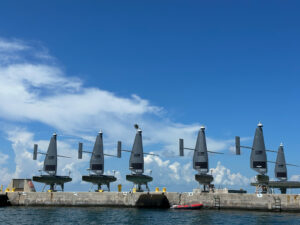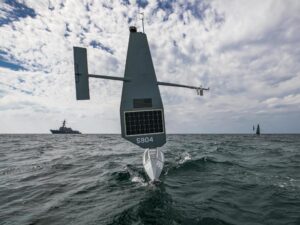The U.S. 4th Fleet deployed 10 Saildrone Voyager Unmanned Surface Vessels (USVs) via commercial operators on Sept. 14 as part of a fleet operation.
The Navy said these USVs are part of the fleet’s Operation Windward Stack, a long-term operation that will consist of unmanned and manned forces working together as a hybrid fleet.

The operation itself is a part of the 4th Fleet’s unmanned integration campaign that seeks to use the fleet’s region to experiment with and operate unmanned systems in a “permissive environment, develop Tactics, Techniques, and Procedures (TTPs) against near-peer competitors, and refine manned and unmanned Command and Control (C2) infrastructure, all designed to move the Navy to the hybrid fleet,” the fleet said in a statement.
The Voyager USVs were launched from Naval Air Station Key West’s Mole Pier and Truman Harbor. Once on station, they are planned to help improve maritime domain awareness in the region by detecting and quantifying targets that pass within their sensor range.
The Navy said the first step in the USVs operations will have operators and watchstanders in Fourth Fleet perform tests and coordinate information flow as they sail in the Caribbean Sea.
“Operation Windward Stack begins with testing as we integrate the information we receive from the Saildrones into our fleet command center to further increase maritime domain awareness in the U.S. Southern Command Area of Responsibility (AOR),” Lt. Cmdr. John Clark, U.S. 4th Fleet’s Current Operations (COPS) Director, said in a statement.
Clark said the fleet plans to ultimately be able to work through the command and control issues for both manned and unmanned forces operating in the region.
For now, these 10 Saildrone USVs are serving as the initial unmanned vessels in Operation Windward Stack.
The service said it plans to add other USVs, unmanned aerial vehicles and manned maritime forces over the following months to complicate and expand command and control integration as well as maritime domain awareness coverage.
In April, Secretary of the Navy Carlos Del Toro and then-Chief of Naval Operations Adm. Mike Gilday announced the Navy was building off of the success in Central Command’s Task Force 59 testing unmanned systems and artificial intelligence by expanding similar operations to the U.S. 4th Fleet (Defense Daily, April 4).
The fleet started these unmanned operations with the annual international UNITAS exercise in July, which used Aerosonde Small Unmanned Aircraft System (UAS), the Maritime Applied Physics Corporation (MAPC) Greenough Advanced Rescue Craft (USV), Boeing [BA] subsidiary Liquid Robotics’ Wave Glider Unmanned Surface Vehicle (USV), Kingfish Unmanned Underwater Vehicle (UUV), LB Glider (UUV), and Marine Corps’ Tactical Resupply Unmanned Aircraft System (TRUAS) (Defense Daily, July 21).
In July, 4th Fleet officials told reporters that their unmanned operations will not be pure experimentation, but focus on trying to operationalize them for longer periods of time.
“We were able to demonstrate coordinated operations of manned and unmanned forces during UNITAS LXIV, a multinational maritime exercise, but that was for a relatively short time,” Capt. David Fowler, U.S. 4th Fleet Maritime Operations Center (MOC) Director, said in a statement with the USV launches.

In contrast, he said Windward Stack will have the fleet “coordinate these operations for many months. That is how we will truly learn what these unmanned vessels can do for us on a day-to-day basis.”
In April, Saildrone first unveiled its Voyager USV as a 33-foot mid-size vehicle designed for near-shore ocean mapping and maritime security missions. At the time, the company said it includes an intelligence, surveillance and reconnaissance sensor suite that has a smart camera array, digital radar, and sub-surface passive acoustics (Defense Daily, April 7).
According to the company, the Voyager mapping suite has a multibeam sonar for seafloor mapping to depths of 900 feet. The USV is mostly powered via wind and solar energy.
Last year, after several Iranian attempts to capture Saildrone USVs in the 5th Fleet area of operation, fleet commander Vice Adm. Brad Cooper told reporters that similar Saildrone vessels being used in Task Force 59 for Fifth Fleet tests have no intrinsic value or classified information kept onboard, because any classified information is continually relayed elsewhere (Defense Daily, Oct. 17, 2022).
“So really, these platforms simply serve as a service and as a passage of information, which we’re then able to take into our headquarters,” Cooper said.